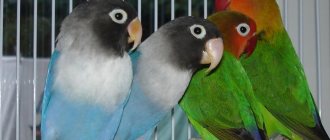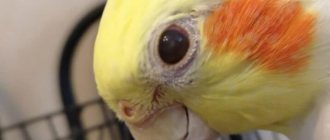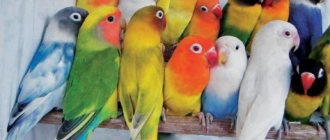Owners of lovebirds have many reasons to admire their pet. This beautiful, cheerful, active bird can lift your spirits, distract you from problems, and forget about loneliness. But not all owners have enough of such communication. I would like to hear human speech from the parrot and adequate responses to requests. It should be taken into account that the features of the vocal apparatus of these birds do not correspond to the required data. It is much easier to teach cockatoos, grays, and even budgies to speak. But if you have patience and follow certain rules, you can achieve the desired result.
Features of lovebirds
For the most part, owners do not complain about the silence of their pets. Lovebirds have a rich vocabulary. Only neighbors can complain about loud chirping, shrill whistles, and screams. But the vocal apparatus, which perfectly creates all these various sounds, imitates human speech poorly. You should not expect long phrases or lengthy arguments from your pet. It is impossible to teach this to a lovebird. But the parrot will be able to pronounce certain words if you train it correctly.
These birds have certain characteristics that dictate the conditions under which positive results can be achieved. It is worth considering that a parrot will not speak if it:
- lives in a couple;
- acquired at an advanced age;
- does not trust the person;
- worried, worried;
- is in an unusual environment.
You should immediately give up trying to train a bird if two parrots live together. Communication with each other is enough for them. Adult pets are also not trainable. It is important to gain the lovebird’s trust and ensure his safety at home. If the chick came into the house quite recently, there is no need to immediately start lessons, the pet will not perceive them.
Who is easier to train: a female or a male?
When choosing a feathered pet in a pet store, everyone probably wondered: do these parrots talk? Considering that they are not very adapted to parody human speech, then there is not much difference between males and females. It is worth noting that female lovebirds do not like to sit still and are always in a hurry to get somewhere. And by nature they are more intolerant and absurd. Males, in comparison, are diligent and diligent students. A boy can show good results after just a month of classes, while a girl will remain at the initial stage.
The way male lovebirds communicate with humans is noteworthy: the pets are friendly, sing a lot, and strive to fly up onto the shoulder. They speak in short words spoken by the owner, but without prompting they will not even think of doing this. In addition, the quality of the words produced cannot be called excellent. Females imitate speech more successfully; they do it as if by accident, but clearly. Not all girls are able to imitate onomatopoeia. If a female lovebird speaks, it means she initially had talent.
Teaching a parrot is not an easy task and not always rewarding. Don’t think about how to teach a lovebird to speak, but get down to business as soon as possible. Perhaps the experience gained will be useful, but it cannot be ruled out that you will give up before your pet. Be that as it may, the bird’s lack of speaking abilities does not detract from its positive qualities.
Preparing for training
To begin with, the parrot should be given the opportunity to get comfortable in its new home. It should be taken into account that this pet can only have one beloved owner, and he will be able to train. Other family members should not be involved in this process. When choosing a “teacher”, it is worth considering that high-pitched children’s and women’s voices are easier for birds to imitate.
The parrot will quickly become tame if you follow a few rules at first:
- provide a comfortable cage, feed at the same time;
- do not let him out of the cage until he gets comfortable;
- maintain silence, routine;
- Do not disturb the cage for several days.
It will take your pet 2-3 weeks to master it. After this, you can allow him to explore the apartment. An important part of taming is hand feeding. You can start taking it during the adaptation period. When placing the cage, you need to take into account that the pet must see the owner’s face. A hungry parrot will definitely take food from the palm of your hand. He will quickly understand that nothing threatens him and will get used to feeding from the palm of his hand. If a bird calmly sits on a hand, it trusts its owner, and we can hope for success in training.
Additional tips for training lovebirds
- The first thing you need to know is that the result of all efforts directly depends on the age of the lovebird. The older the pet, the less hope for success. You can start speaking practice with 4-5 month old chicks.
- Lovebirds are paired creatures. But joint education will not bear any fruit. The parrots will be too busy with each other.
- Praise and encourage the student. Even for the smallest successes. Emotional support will be a good incentive to continue studying. Well, and treats, where would we be without them?
Lovebird parrot. Speaking parrot.
Choosing a vocabulary for your pet
Don't set impossible goals. Even with complete trust in the owner and compliance with the rules, the parrot will be able to master only a few words in a year. You can choose them at your own discretion. The main word, of course, is the nickname, which the bird hears regularly. For your pet's vocabulary, you need to choose short, simple options.
Experts recommend giving preference to words with vowels “o” and “a” and consonants “r”, “k”, “ch”, “t”, “p”. There is no need to try to immediately learn phrases with your pet. This will not bring success. You should not move on to the next word if the parrot cannot yet pronounce the previous one well and clearly.
Female and male lovebirds have different learning abilities. Many experts believe that female parrots should not be messed with; they are silent and aloof. Speech talents in females are very rare. In total, a lovebird's vocabulary can contain up to twenty words. If you work with your pet correctly and regularly, you can ensure such a vocabulary.
What the owner will receive after several years of painstaking work
You can only be sure that your lovebird is capable of imitating human speech through experience. If you have the desire and time, you need to start daily exercises. In a year, a bird can learn no more than 2 words. But she will pronounce them clearly. Basically, for memorization, they choose the name of the pet and a couple of very simple phrases. Over the course of its entire life, a motley bird can be trained to pronounce about 10 words. But lovebirds speak clearly and correctly.
On a note! A talking lovebird is a real rarity and pride among poultry houses. This is also evidence and an answer to the question of whether it is possible to teach a lovebird chick to speak clearly at home.
Rules for conducting classes
It is clear that a modern person’s day is scheduled minute by minute and there is little free time. But if you want to achieve success in training a lovebird, you will have to make certain adjustments to your regime. There are several recommendations worth paying attention to:
- Classes in the first half of the day are more effective. By evening, the pet gets tired, and perception worsens.
- The duration of lessons should be 20-40 minutes. Less time will not provide results. A longer lesson will tire the parrot.
- There should be no strangers, music, or loud noises in the room.
- Words must be pronounced clearly, loudly, always with the same intonation, so that it is easier for the bird to imitate sounds.
The parrot can choose the most productive moment for training himself. If he sits on your hand, looks into your eyes, flaps his wings, clicks, he is ready to talk. This opportunity should not be missed, even if it is outside of class hours.
Many owners who want to teach their lovebird human speech use technical means as an assistant. You can take a voice recorder, player, or any other device that reproduces sound in good quality. The word that the parrot needs to learn is written down at high speed. There should be a break of about 15 seconds between each repetition. The device is placed near the cage and turned on.
Experts consider this method effective. But you need to take into account that the parrot will not learn faster if it listens to the recording for hours. It will gradually become a normal background for it, the bird will stop paying attention to it. Listening should take no more than 40-45 minutes. During this time, the pet is able to learn the lesson.
The parrot must be rewarded for its success during training. Every pet has a favorite treat. You need to stock up on it in order to praise him for good repetition and attentiveness, to show how the owner likes his efforts. The lovebird should also be given treats after classes, regardless of success. Classes must be regular. Long breaks will significantly reduce efficiency.
How to teach a parrot to talk
For learning, it is necessary to create a calm, friendly environment in the home. Extra sharp sounds, flashing of people and animals will only distract the bird from its activities. The lovebird parrot talks only to its owner.
How to teach a domestic lovebird to talk, training rules:
- Care and affection are the main trump card to “talk” your pet. You can treat him with his favorite delicacy, invite him to sit on your palm.
- You need to talk to the bird quietly, clearly repeating the right words.
- You can attract the bird's attention with his favorite toy. Show it and repeat the phrase.
- Classes are held in the morning. At this time, the birds' attention is sharpened and they respond better to sounds. Lesson duration is at least 40 minutes. In the evening, the exercises can be repeated.
- The first word a parrot must learn is its name. Therefore, when naming a small chick, choose a short, monosyllabic name. The nickname will help teach the young lovebird to speak clearly.
- During each feeding, the bird is addressed by name. They speak to him kindly. Over time, he will react to this word and begin to respond to his nickname.
- The easiest words for parrots are those that have a lot of vowels, especially “a” and “o”. You can pick up a few of these short words and repeat them often. Over time, you can try to learn longer phrases with your pet.
- You should not say several words at once. For a parrot, this is a mess of sounds. They start with one very simple word. They pronounce it loudly enough, but so as not to frighten the pet. You will have to repeat the word often and for a long time until the bird masters it.
- Is it possible to teach a bird to repeat several words? As soon as the lovebird begins to clearly and distinctly pronounce a simple word, you can try to teach him another.
- As soon as the bird starts talking, you must immediately thank it with a piece of your favorite fruit or a cracker. This will encourage your feathered pet to work more diligently.
On a note! If you follow all the rules and create comfortable conditions for the motley bird, within a year, it can be taught to speak 2-3 simple words.
Description and features
Love parrots get their name from a legend that is not actually true. The essence of the legend is that if one of the love birds dies, its partner cannot live any longer due to deep sadness and also dies.
In reality, this does not happen, although the lovebirds feed and rest together, never leaving each other for a minute. In nature, love birds do not live in pairs, but as a family, a flock. In case of conflicts between members of the flock, the weakest parrot leaves them for a while and then returns.
Taming parrots is usually not difficult, due to the fact that in addition to their striking appearance, parrots are very popular. In general, they are unpretentious in the apartment, and they also love active activities and outdoor games, so it’s nice to watch them.
Monoecious parrots are practically unsuitable for training, and it is also difficult to teach a parrot to remember words. Parrots speak very rarely; birds can remember and remember up to ten words.
Loving birds prefer to live in pairs or small flocks.
The main advantage is the irresistible appearance of the bird, as evidenced by photos of love birds. The feathers are colored in light shades, with the predominant color being green. Often certain parts of a parrot's body attract attention with different colors: blue, yellow and red.
These birds cannot be called large - the body of an average parrot reaches a length of no more than 17 cm, the tail is 5 cm, the wings are 10 cm, and the bird weighs about 50 g. Thanks to their short legs, parrots can run quite quickly and deftly on the ground and climb trees .
The bird's beak has a curved shape and is particularly durable. Typically, the lovebird's beak is yellow or red. Despite their small size, parrots can resist enemies thanks to their strong beak.
Important! It is not recommended to keep parrots in the same cage with birds of other species, as they are considered very jealous and can attack the enemy regardless of its size.
What not to do while studying
In order for lessons to be enjoyable and fruitful for both parties, the following must be avoided:
- Do not cover your parrot's cage. Although this is widely used in raising feathered pets, it cannot be done. Isolation will not lead to anything good. The bird will be stressed. Communicate and play with your lovebird; this alone is the key to his good mood and interest in learning.
- Do not scold or be aggressive during training. There is no need to shout at the student, this will scare him and discourage him from learning. Your conversation should be calm and your mood good.
Patience is the key to the successful outcome of any training.
The whole truth about lovebirds: these birds love to misbehave
Buy birds from a safe place
It is better to buy a parrot from a breeder - in this case, it will already be tame, non-aggressive and socialized. Since these birds usually live in pairs (they are uncomfortable alone), it is advisable to take two lovebirds at once. Immediately check with the former owner what he fed the birds and whether there are any features in their maintenance that he would like to tell you. It is not advisable to buy birds at a pet store, since you may get a sick parrot there, because, frankly, they keep birds there in conditions that are far from ideal.
Lovebirds are unlikely to speak
Before purchasing, you need to clearly understand that these parrots usually do not speak, especially if they live in pairs. However, there are isolated cases when a lovebird can be taught to pronounce individual words (literally several). Most often, it is possible to get “speaking” from pink-cheeked lovebirds, and at the same time, this species is famous for its combative, hooligan character. By the way, the lovebird does not pronounce words as clearly as, for example, a macaw, a gray parrot, or the same budgerigar, so the owner has to listen carefully to make out what he is saying.
But these birds are very smart, and if desired, they can be taught simple commands. For example, flying to your call, returning to the cage after walking around the apartment, or dancing.
Birds need space
The cage for a pair of lovebirds should be large so that they have the opportunity to fly from perch to perch and stretch their wings, and not just sit in one place. In addition, birds should be regularly allowed to fly around the room. Remove all things that are unstable, because lovebirds can throw them onto the floor or may themselves become victims of a fallen heavy object. Houseplants that may be poisonous should also be removed. And don't leave the windows open!
The air must be clean
Lovebirds, like budgies, are very susceptible to strong odors. In the room where the bird cage is located, under no circumstances should you work with paint, spray air fresheners or perfume, or use nail polish. For the same reason, it is not advisable to keep the cage in the kitchen, because you cannot exclude the possibility that the food on the stove will burn and smoke will come out. And of course, smoking in a room where a bird is located is strictly unacceptable. The respiratory system of lovebirds is very delicate, and strong odors can cause poisoning and death.
Hygiene is vital
Change the food and water in the cage every day. If the bird has eaten, do not add grain to the feeder, but throw away the old, uneaten food, rinse the container and add new food into it. The grains should not smell rotten or damp; check their freshness regularly. At least once a week, the cage should be cleaned and the bars should be wiped with special non-toxic products. Change the bedding in the cage at least every other day, preferably daily. It is better if you put plain paper on the bottom, but not advertising newspapers, since their paint can cause poisoning in birds.
Do not use questionable food
When feeding lovebirds, you need to take into account the characteristics of this species. The mixture sold for budgies or large parrots is not suitable for them. Choose food that is designed for medium-sized parrots. As a rule, its main part is millet. Give preference to serious, well-known manufacturing companies, and do not be guided by the principle of “what is cheaper”.
In the summer, as a supplement to the main (store-bought) food, which usually already contains all the vitamins and microelements the bird needs, you can give lovebirds greens. For example, dandelion, plantain, clover or lettuce leaves. Birds also usually love fresh fruits and vegetables: apples, carrots, bananas, bell peppers, zucchini. However, you must be completely sure that the fruits do not contain nitrates, which can kill birds. Therefore, it is advisable that these be fruits or vegetables from your own garden or from a trusted store.
Lovebirds also enjoy snapping sunflower, melon or pumpkin seeds. Naturally, they should be raw, not fried or salted.
Lovebirds need to be educated
These birds are beautiful and charming, but at the same time unusually smart, cunning and capricious. Due to curiosity and a desire to misbehave, they will poke their nose into the most unexpected places in the apartment, so you need to monitor their movements (for their own safety) and not allow them to misbehave. For example, they like to chew something or throw things off shelves, which, naturally, will not make you happy. Therefore, raise your parrots from the very first days. They, of course, will not obey you unquestioningly, like dogs, but they are still able to understand that the owner does not like some of their actions, and they correctly pick up the strict intonation of the voice.
They are very affectionate with each other
A pair of lovebirds is a very interesting object to observe. They care for each other unusually tenderly and coo sweetly. In general, as their name implies, water will not be spilled. A bird experiences the loss of its mate very hard, and in this case it is advisable to immediately find a mate for it again. By the way, the common belief that after the death of a partner the inconsolable lovebird dies is just a beautiful legend. In fact, this only happens for completely natural reasons. For example, if one bird gets sick and the second one becomes infected from it. Or if both birds were already old. So most lovebirds are quite willing to agree to a “second marriage.”
By the way, they are quite comfortable in a flock of several pairs. But these birds are not friends with other types of parrots, therefore, if lovebirds live in your home, it is advisable to exclude their contacts with “strangers”.
Dear readers!
Send your questions and suggestions to [email protected]
Necessary qualities for training birds
Patience, patience and again – patience. Nothing will work without him. Teaching a lovebird to speak is a difficult task. Therefore, those who have no time to wait should not start this business.
Love and regularity of classes. Every day you need to work with the motley bird several times for an hour. If you miss even one lesson, there will be no result. And of course, only with affection and attention can you attract the attention of a lovebird and make him speak the same language as you.
Teaching a parrot to speak is not easy, and especially a lovebird. It is important to make these activities not serious and strict lessons, but fun get-togethers with treats. By communicating closely with his pet, the owner gains another family member.











